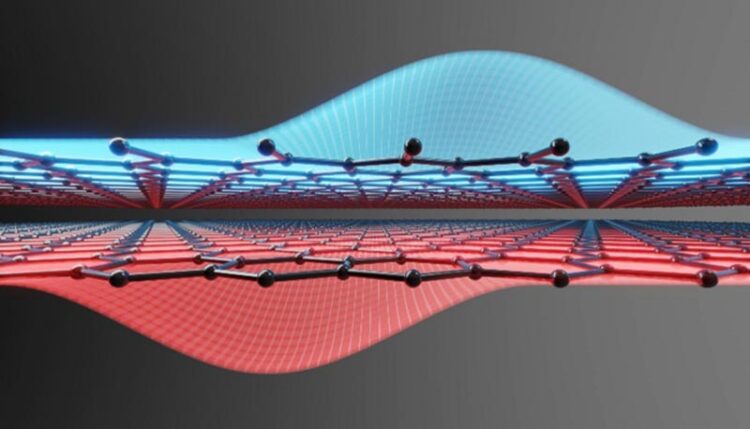Symmetric graphene quantum dots for future qubits

Artist's impression of bilayer graphene with an electron-hole symmetric double quantum dot, where the electron and the hole are in different layers.
Credit: Sebastian Staacks
Quantum dots in semiconductors such as silicon or gallium arsenide have long been considered hot candidates for hosting quantum bits in future quantum processors.
Scientists at Forschungszentrum Jülich and RWTH Aachen University have now shown that bilayer graphene has even more to offer here than other materials. The double quantum dots they have created are characterized by a nearly perfect electron-hole-symmetry that allows a robust read-out mechanism – one of the necessary criteria for quantum computing. The results were published in the renowned journal Nature.
The development of robust semiconductor spin qubits could help the realization of large-scale quantum computers in the future. However, current quantum dot based qubit systems are still in their infancy. In 2022, researchers at QuTech in the Netherlands were able to create 6 silicon-based spin qubits for the first time. With graphene, there is still a long way to go. The material, which was first isolated in 2004, is highly attractive to many scientists. But the realization of the first quantum bit has yet to come.
“Bilayer graphene is a unique semiconductor,” explains Prof. Christoph Stampfer of Forschungszentrum Jülich and RWTH Aachen University. “It shares several properties with single-layer graphene and also has some other special features. This makes it very interesting for quantum technologies.”
One of these features is that it has a bandgap that can be tuned by an external electric field from zero to about 120 milli-electronvolt. The band gap can be used to confine charge carriers in individual areas, so-called quantum dots. Depending on the applied voltage, these can trap a single electron or its counterpart, a hole – basically a missing electron in the solid-state structure. The possibility of using the same gate structure to trap both electrons and holes is a feature that has no counter part in conventional semiconductors.
“Bilayer graphene is still a fairly new material. So far, mainly experiments that have already been realized with other semiconductors have been carried out with it. Our current experiment now goes really beyond this for the first time,” Christoph Stampfer says. He and his colleagues have created a so-called double quantum dot: two opposing quantum dots, each housing an electron and a hole whose spin properties mirror each other almost perfectly.
Wide range of applications
“This symmetry has two remarkable consequences: it is almost perfectly preserved even when electrons and holes are spatially separated in different quantum dots,” Stampfer said. This mechanism can be used to couple qubits to other qubits over a longer distance. And what’s more, “the symmetry results in a very robust blockade mechanism which could be used to read out the spin state of the dot with high fidelity.”
“This goes beyond what can be done in conventional semiconductors or any other two-dimensional electron systems,” says Prof. Fabian Hassler of the JARA Institute for Quantum Information at Forschungszentrum Jülich and RWTH Aachen University, co-author of the study. “The near-perfect symmetry and strong selection rules are very attractive not only for operating qubits, but also for realizing single-particle terahertz detectors. In addition, it lends itself to coupling quantum dots of bilayer graphene with superconductors, two systems in which electron-hole symmetry plays an important role. These hybrid systems could be used to create efficient sources of entangled particle pairs or artificial topological systems, bringing us one step closer to realizing topological quantum computers.”
The research results were published in the journal Nature. The data supporting the results and the codes used for the analysis are available in a Zenodo repository. The research was funded, among others, by the European Union’s Horizon 2020 research and innovation program (Graphene Flagship) and by the European Research Council (ERC), as well as by the German Research Foundation (DFG) as part of the Matter of Light for Quantum Computing (ML4Q) cluster of excellence.
Journal: Nature
DOI: 10.1038/s41586-023-05953-5
Method of Research: Experimental study
Article Title: Particle–hole symmetry protects spin-valley blockade in graphene quantum dots
Article Publication Date: 3-May-2023
Media Contact
Tobias Schloesser
Forschungszentrum Juelich
t.schloesser@fz-juelich.de
Office: +49-246-161-4771
Media Contact
All latest news from the category: Physics and Astronomy
This area deals with the fundamental laws and building blocks of nature and how they interact, the properties and the behavior of matter, and research into space and time and their structures.
innovations-report provides in-depth reports and articles on subjects such as astrophysics, laser technologies, nuclear, quantum, particle and solid-state physics, nanotechnologies, planetary research and findings (Mars, Venus) and developments related to the Hubble Telescope.
Newest articles

Bringing bio-inspired robots to life
Nebraska researcher Eric Markvicka gets NSF CAREER Award to pursue manufacture of novel materials for soft robotics and stretchable electronics. Engineers are increasingly eager to develop robots that mimic the…

Bella moths use poison to attract mates
Scientists are closer to finding out how. Pyrrolizidine alkaloids are as bitter and toxic as they are hard to pronounce. They’re produced by several different types of plants and are…

AI tool creates ‘synthetic’ images of cells
…for enhanced microscopy analysis. Observing individual cells through microscopes can reveal a range of important cell biological phenomena that frequently play a role in human diseases, but the process of…





















